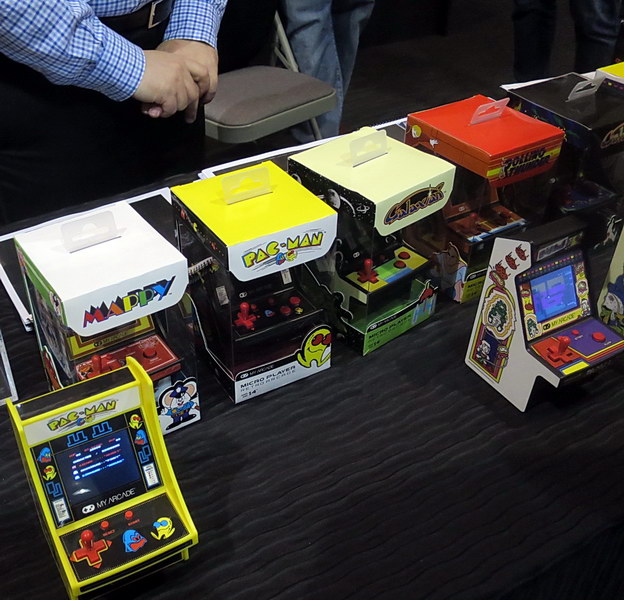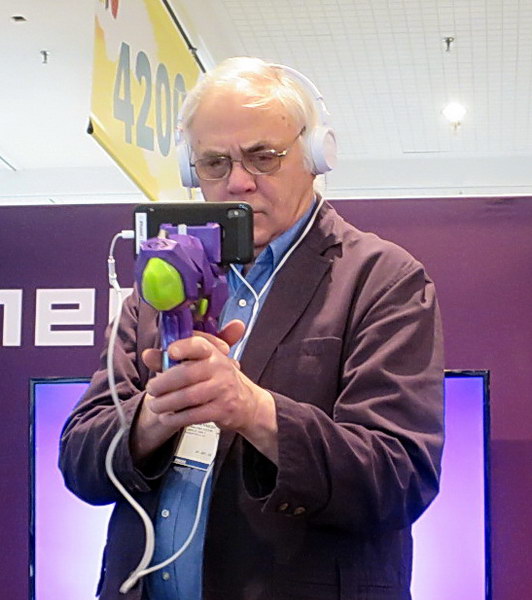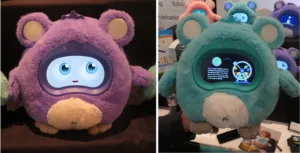The Toy Fair in New York has just ended. It may be February, but everyone there was looking forward to Christmas, in particular the Christmas selling season. While most of the toys on display did not use display technology, there were a number of interesting exceptions.

Some toys had built in displays and even more were designed to be used with a smartphone or tablet. Many of the smartphone-based toys were based on the ideas of Augmented Reality (AR) or Virtual Reality (VR). Others used the smartphone as an alternative to a dedicated remote control unit.
 Entrance to the Toy Fair at the Javits Center in New York. (Credit:. M. Brennesholtz)
Entrance to the Toy Fair at the Javits Center in New York. (Credit:. M. Brennesholtz)
The built-in displays in many toys are very low quality in order to keep the price of the toy down. According to the Toy Industry Association, the sponsor of the Toy Fair, the average price of a toy is about $10. Even though a $100 toy is considered very high priced for a mass-market toy, keeping the price down in display-centric toys may not be the right approach. Kids today, especially ones who might get a $100 toy, are accustomed to very high quality displays in their life, tablets, smartphones and computers. Why shouldn’t they get similar displays in their toys?
Woobo has a high resolution, touch screen display. (Credit: M. Brennesholtz)
Woobo does not take the low-cost approach. They use an 800 x 600 touch screen display as part of their $179 toy. Some tablets cost less than that and I suspect Woobo is really the insides of a tablet with a plush toy wrapped around it. When Woobo’s screen isn’t doing something else, it is showing a rather appealing face, as shown in the left half of the image. The eyes blink and when Woobo talks, the lips move, synchronized with the voice. The face display can also show a variety of information, as shown in the image on the right. This image is showing information about light from the sun but many other things can be shown, from games to reminders from Mom.
The main Woobo/child interface is not, in fact, the touch screen or the buttons on the two ears, but voice. According to Feng Tan, CEO and Co-Founder of Woobo, you can think of Woobo as Alexa for kids. It can answer questions like “Why is the sky blue?” It can also be programmed remotely by a parent. For example it can wake a child up at a specific time and remind him to brush his teeth before coming to breakfast.
Woobo started as a Kickstarter project in 2017. The company raised $360,000 total while selling 3,000 units. Feng Tan, CEO and Co-Founder told me all 3000 units were delivered on time, i.e. before Christmas 2017. The company was at the Toy Fair hoping to launch the toy into the mass market.
 Miniature arcade games from My Arcade. (Credit: M. Brennesholtz)
Miniature arcade games from My Arcade. (Credit: M. Brennesholtz)
My Arcade was also at the Toy Fair with display-centric games and took the low cost path. Their miniature arcade games use 2.5” color screens with 8 or 16 bit drive. I asked at the Toy Fair booth what the resolution was but no one seemed to know or, for that matter, care. How much resolution do you actually need to play Pac-Man? Their games have MSRPs in the $40 price range and I saw one at the US retailer Kohl’s at about half that.
 Gamer Kit from Tech Will Save Us (Credit: M. Brennesholtz)
Gamer Kit from Tech Will Save Us (Credit: M. Brennesholtz)
I saw quite a few toys at the Toy Fair that were intended to teach children how to code. One of these, from Tech Will Save Us, was interesting because it included a very low resolution display – 8 x 8 monochrome pixels. When a child got this toy, first thing she had to do was assemble her game system. Then she could play the pre-installed games or code her own. One of the ideas was the child would not only learn how to code but would learn about displays and computer graphics as well. All at a low enough technical level for a child to understand, of course.
 Meko’s Matt Brennesholtz tries the 6DoF Blaster from Merge VR (Credit: M. Brennesholtz)
Meko’s Matt Brennesholtz tries the 6DoF Blaster from Merge VR (Credit: M. Brennesholtz)
Most of the AR and VR systems at the Toy Fair were fairly straightforward: you pointed your smartphone camera at a book, an object or an icon and Captain America, a Magician or a cute bunny popped out of the book on your smartphone screen. The 6DoF Blaster from Merge VR seemed to avoid this mundane approach, however. The system was a toy gun and you supplied your own iOS or Android smartphone. The system used the 6 degrees of freedom sensors in the smartphone to track you as you moved around, ducked under low ceilings, walked around the room and searched for bad guys behind you.
The system avoids the disorientation problems of 6DoF motion when using a HMD by allowing you to see the real world around you even while you are focusing on the virtual world shown on the smartphone, which acts as the gunsight for the toy. By covering such a small portion of the users field of view, it also provides a very high resolution image – essentially the native resolution of the smartphone screen. This system has a MSRP of $39.99, without the smartphone, of course.
One last toy – a dollhouse. But not a regular doll house, but a smart home dollhouse. A dollhouse wired with all the Internet of Things stuff you could want. Controlled by your smartphone, of course. –Matthew Brennesholtz

